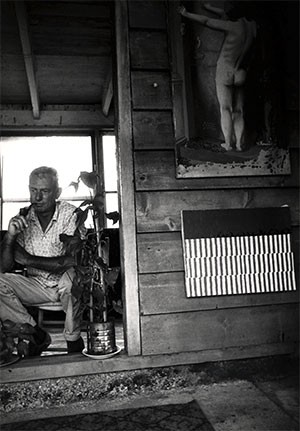Forrest Bess
Born 1911, died 1977, Bay City, Texas
For more than twenty years, Forrest Bess worked as a bait fisherman on a remote island along the Gulf Coast of Texas, spending his nights and off-season days painting. He showed an early interest in art and studied architecture in college before enlisting in the military in 1941. Bess began to paint again on the advice of a psychiatrist following a violent head injury sustained at the hands of recruits who suspected him of being gay. In subsequent years, his geographic isolation was broken only by the correspondence he carried on with prominent figures in the worlds of art and science and by the intermittent exhibition of his paintings at the Betty Parsons Gallery in New York between 1949 and 1967. In 1974, after years of illness, Bess was institutionalized with a diagnosis of paranoid schizophrenia. Interest in his work was briefly rekindled in the 1980s when he earned a cult following among artists.
During the early years of abstract expressionism, Bess’s biomorphic paintings fit well with Parsons’s stable of artists, which also included Jackson Pollock and Mark Rothko. Like these painters, Bess developed an intensely private symbolic language, influenced by Jungian notions of the unconscious. But whereas the abstract expressionists increasingly viewed painting as a terrain for improvisatory action, Bess approached it as a medium for translating the hallucinatory visions he experienced between sleep and waking. Working on an intimate scale, he faithfully depicted these images and symbols, using thick impasto and inventive textures.
An avid reader of mythology, anthropology, and sexology, Bess considered painting as part of a lifelong project of metaphysical inquiry, which culminated in an extensive “thesis” about the merging of masculine and feminine energy. Parsons would not display this research in her gallery, and his wish to present his paintings and theories side-by-side was realized only posthumously. In 2012 artist Robert Gober organized a selection of Bess’s output as his contribution to the Whitney Biennial. While the latter’s treatise is lost, Gober presented several pages from it preserved in the archive of art historian Meyer Schapiro as well as documentation of the experimental surgeries Bess performed on himself to achieve a hermaphroditic state.
Jenevive Nykolak
Elliot, Claire, ed. Forrest Bess: Seeing Things Invisible. With Robert Gober. Houston: Menil Collection, 2013.
